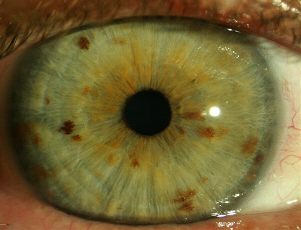Irodology part 3
In Iridology 1 and 2 I discussed a brief history, how it works, research and what its uses and limitations are. In this section, we will examine the more practical side of it.
Iris Colour.
The concentration of melanin determines the iris colour. Basic colours are blue, grey and brown and mixed iris (brown overlay over blue base) due to pigment distribution and light reflection. Green results from abnormal yellow colouration in the blue iris.
Constitution
Constitution is the sum total of the patients inherited characteristics. It is determined by hereditary factors or Genotype and influenced by environmental factors or phenotype. There are 3 Constitutions. Lymphatic, Haematogenic and Mixed.
Disposition
Disposition describes specific structural gene variation according to latent inherited signs and can always be seen. They may remain latent or be triggered or activated. There are five dispositions. Neurogenic, Glandular, Vegetative spastic, Tubercular and Connective tissue weakness (CTW)
Diathesis
Diathesis describes a specific regulatory gene variation. It is the inherited or acquired susceptibility to morbid changes within specific organs or organ systems. There are 5 types. Allergic, Hyper acidic, Dyscratic, Lipaemic and Hydrogenoid-Exudative.
Consultation
First of all, a complete medical history of the patient is recorded. The eyes are then examined using a specialised microscope. Photographs of the iris are taken through the microscope, and transferred to a computer. This is necessary to show the patient what is observed and what may be the problem that is causing a reaction or condition in the body. The use of a hand lens is insufficient as the finer details and structures cannot be observed or recorded. A physical examination and or blood tests may be requested in order to make a complete diagnosis in certain cases, this however is not always necessary. Let’s briefly examine the eye of a patient of mine.
Case study.
(Please excuse picture quality as resizing etc had to be implemented for printing)
There are many signs in the iris, however we will just deal with a few of them relating to the case as seen in the photograph which I took below.
Patient complained of fatigue, irritability, loss of appetite, insomnia, diarrhoea and nausea.
Constitution, Lymphatic: Disposition, Neurogenic: Diathesis, Dyscratic.

There are multiple Nerve or Cramp rings (look like folds) throughout the iris and are more clearly visible on the left side between 06h00 and 12h00 together with the wagon wheel appearance surrounding the pupil, which could cause IBS as patient internalises his emotions. These rings also affect his breathing as they pass through the lung region. There is central heterochromia (yellow colour) extending lightly into the iris with partial atrophy of the IPB. This indicates a hypoglycaemic or sugar imbalance in the patient with a strong possibility of diabetes or insulin resistance developing. Vascularised radials in the liver, biliary system at 07h30 to 08h00 together with dark spots (Dyscratic markings) distributed throughout the iris are indicative to Liver and pancreas taking strain. Toxins are accumulating in the lymphatic system and the kidneys are not performing efficiently. There are also indications of a subluxation (vertebral misalignment) of the spine in the cervical and thoracic- lumbar region (patient had a fall) which I corrected using pressure points (NPR).
I suspected alcohol abuse and sent the patient for liver function blood tests to confirm my diagnosis. The results were shocking, indicating early stages of alcoholic hepatitis. When confronted with the diagnosis, the patient admitted to consuming vast amounts of alcohol every evening and sometimes during the day. A treatment program was prepared by me specifically for him. He is also at the AA and has shown remarkable progress to date.
Iridology helps us understand our weakness so we may strengthen and cleanse our bodies to obtain our maximum health potential. It brings to us an awareness of how to prevent illness, thus allowing us to earn our most precious earthly treasure--vibrant physical, mental and spiritual health! Iridology can play an important role in preventative medicine at the bioelectric level, which is well on its way to becoming the medicine of the future.
The main aim of iridology is to keep you healthy by recognizing early signs of possible problems and recommending holistic and natural treatments to prevent them from developing into more serious problems. The greatest benefit of iridology over other forms of health screening is that changes appear in the iris before the physical symptoms develop. Hence a preventative action can be taken early to improve your health and can avoid those diseases which might appear
.
“A good physician cures an illness, a brilliant one prevents it.”